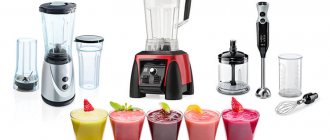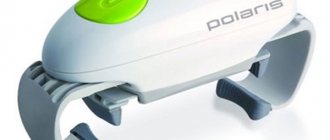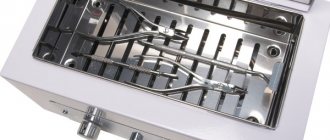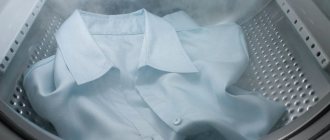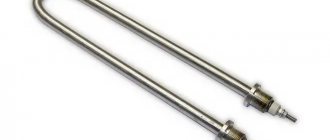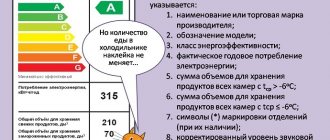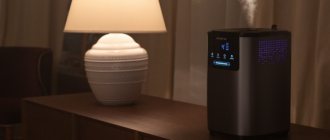How the device works
The air flow with the help of a fan penetrates the inlet of the recirculator, after which it enters the ultraviolet (UV) radiation zone, where it is cleaned.
As a result, clean air is released through the outlet louvers. Bacteria are destroyed.
Bactericidal recirculator.
Open sources.
Operating principle
The operation of the device is based on recirculation of air flow with exposure of air to ultraviolet radiation of a certain spectrum. At a wavelength of 180–300 nm, it has a bactericidal effect on microorganisms - it damages the DNA of the cell nucleus of bacteria and destroys them, stopping their growth. To destroy viruses, more powerful UV radiation is required - 300–380 nm.
The device works as follows:
- using a fan, an air flow is forced into the housing through the inlet (blinds);
- it passes through the radiation exposure zone and is disinfected;
- clean air is released through the outlet louvers.
The efficiency of modern devices reaches 95 percent or more.
Why should you choose a closed type device?
All of the above applies to closed type recirculators - they are completely safe for humans, so you can be near a working device without harm to your health.
Closed recirculators are perfect for home, office or educational institutions. Open type devices are used, as a rule, in medical institutions, and here's why.
If closed-type devices disinfect the air, then the open type can also quartz all surfaces in the room thanks to direct UV rays.
In other words, with a closed type, air disinfection occurs inside the device, and with an open type, UV radiation spreads throughout the room. Direct exposure to powerful ultraviolet radiation on people can cause damage to health, causing conjunctivitis and even burns.
Therefore, when quartzing an open-type device, the presence of people or animals is excluded, and the one who turns on the device must wear safety glasses.
Doctors. Pandemic
MTR.
How does an irradiator-recirculator work?
The device is actually a chamber for bactericidal air treatment using ultraviolet radiation. Inside the housing there are lamps that generate UV radiation. Their number may vary depending on the specific model. The design of the recirculator also includes a fan; it circulates air parallel to the lamps. The housing has a screen that transmits light from the visible part of the spectrum into the surrounding space, making it possible to visually monitor the operation of the device. UV radiation is blocked by the screen. Thanks to this, it is possible to disinfect the air when people are present in the room.
Where can a bactericidal recirculator be used?
We asked a pharmaceutical representative where a bactericidal recirculator could be used.
By and large, the device can be installed in any room, but it is necessary to take into account the degree of air purification.
According to the expert, premises can be divided into five conditional categories, in each of which it is necessary to achieve a certain “air purity”.
Bactericidal recirculator.
Open sources.
- Category I - operating room, preoperative room, sterile areas and children's wards of maternity hospitals. Sterility must reach 99.9%
- Category II - laboratory, blood transfusion stations, pharmaceutical workshops, etc. Disinfection - 99%
- Category III - medical and preventive institutions, wards with patients. Sterility - 95%
- Category IV - office premises, game rooms, school classrooms and shops. Disinfection - 90%
- Category V - living rooms, smoking rooms, staircases. Sterility - 85%
A representative of Ecomedic notes that excessive sterility in a room can even harm residents, as it will weaken the immunity of the people there.
How loud do recirculators make when operating?
The sound created by one- and two-lamp recirculators does not exceed 40 decibels. This is no louder than most air conditioners.
The advantages of these devices are obvious - they will reliably protect you from influenza, ARVI and other diseases. This device is especially necessary if there are people in your family who are more vulnerable to infections - the elderly, children, people with weakened immune systems.
Application. Categories of premises subject to treatment with bactericidal irradiators-recirculators (in accordance with Guideline R 3.5. 1904–04 of the Ministry of Health of the Russian Federation).
- Category I: sterile areas of the central sterilization department (central sterilization departments), operating rooms, postoperative rooms, and maternity wards. Children's wards of maternity hospitals, wards for premature and injured children;
- Category II: rooms for sterilization and pasteurization of breast milk, dressing rooms, wards and departments of patients with weakened immune systems, wards of intensive care units. Virological and bacteriological laboratories, premises of non-sterile areas of the central care center, pharmaceutical workshops, blood transfusion stations;
- Category III: offices, wards and other premises of medical institutions (not included in categories I and II);
- Category IV: school classrooms, children's playrooms, domestic premises of industrial buildings and public buildings, in which a significant number of people are present for a long time;
- Category V: public toilets, smoking rooms and stairwells of medical institutions.
The presented article is for informational purposes only. To establish an accurate diagnosis and prescribe the correct treatment, be sure to consult a doctor.
How to choose a recirculator for the right room
The sterility that the device can provide is calculated from two values: the area or volume of the room and the power of the lamps.
Employee :
The minimum power of the device is 8 W, such devices are designed for approximately 8-9 sq. meters. It is also important to consider how much space the furniture takes up in the room.
As an example, let’s take the Armed CH 111−130 M/1 recirculator. The first digit in the device indicates the number of lamps, in this case 1 lamp is indicated. The last 2 indicate the power of the lamp - here it turns out to be 30 W. There are devices with two 15-watt lamps, which will accordingly disinfect 30-40 square meters. meters.
Medical ward.
Daria Zykova
However, you rarely have to resort to such calculations. The optimal area of the room in which the device will operate is usually indicated in the product passport.
But we still recommend seeking help from consultants.
What can't a recirculator handle?
Against the backdrop of a large number of advantages, recirculators have perhaps one disadvantage. Although it effectively copes with air disinfection, it is unable to disinfect surfaces. There are several solutions for this: constantly treat surfaces with antiseptics or use an ozonizer when people are not present. With antiseptics, everything is less clear. What is ozonation?
Ozonation is a progressive method of combating viruses and infections. An ozonizer can not only disinfect the air, but also all surfaces, even in the most inaccessible places. Being a gas, ozone penetrates everywhere and disinfects everything it comes into contact with . The disadvantage of ozonation is that it cannot be used in the presence of people, since ozone gas itself is poisonous. However, after 1-2 hours there is no trace left of it, and turning on the device for 15-20 minutes is enough.
How long will UV lamps last?
Service life is an average of 8000 hours. If you use the recirculator daily for 8 hours, the lamps will last you about 2.5 years. Some models have a counter that records the hours the lamp has been used, so you will always know when you need to replace components.
According to an Ecomedic employee, if the device does not have such a meter, then the lamp, having served its intended period, will burn very dimly or stop working completely.
Mask. Coronavirus.
CC0
Where can you buy recirculators in Barnaul?
In the capital of the Altai Territory there are quite a lot of companies offering such medical equipment.
The cost of a bactericidal recirculator can range from 8 to 30 thousand rubles, depending on the type of model and the power of the lamps.
Here are some of the most interesting options.
Read more
1−130 PT. 1 lamp 30 W. Recommended area: 30 m2.
Coronavirus. Medicine.
CC0
Trading
There are two devices available:
- OBNR 2×15 “Crystal-3”. Productivity: 85 m3/h. Wall. The duration of continuous operation is at least 8 hours. A counter is installed that determines the operating time.
- Also, according to a company representative, there is a consumer version of “Crystal 3” available without a registration certificate. It has similar characteristics as the previous device.
- MTL 115. Designed for rooms with a volume of up to 70 m3 and an area of up to 30 m2. 1 lamp 15 W.
- MTL 215 Designed for rooms with a volume of up to 100 m3 and an area of up to 42 m2. 2 lamps with a power of 15 W.
- MTL 130 Designed for rooms with a volume of up to 150 m3 and an area of up to 55 m2. 3 lamps with a power of 15 W.
- MTL 315 Designed for rooms with a volume of up to 150 m3 and an area of up to 62 m2. 4 lamps with a power of 15 W.
- MTL 415 Designed for rooms with a volume of up to 200 m3 and an area of up to 71 m2. 1 lamp 30 W.
- MTL 230 Designed for rooms with a volume of up to 300 m3 and an area of up to 107 m2. 2 lamps with a power of 30 W.
- MTL 330 Designed for rooms with a volume of up to 300 m3 and an area of up to 125 m2. 3 lamps with a power of 15 W.
- MTL 430 Designed for rooms with a volume of up to 350 m3 and an area of up to 140 m2. 4 lamps with a power of 15 W.
All devices except the first can be used in rooms of IV categories; MTL 115 should be installed in all except the first category.
Coronavirus. Medicine. Analyzes.
CC0
- Irradiator-recirculator "Armed" SN 111−115 (metal body) - 1 lamp. Recommended room volume 30 m³.
- Irradiator-recirculator "Armed" 2−115 P (plastic body) - 2 lamps. Recommended room volume 60 m³.
- Irradiator-recirculator "Armed" SN 311−115/M1 (metal housing) - 3 lamps. Recommended room volume 90 m³.
- Irradiator-recirculator “RTsMS-60” (metal housing) - 4 lamps. Recommended room volume is 35−110 m3.
- Irradiator-recirculator “RTsMS-90” (metal housing) - 6 lamps. Recommended room volume 60−165 m3.
- Irradiator-recirculator “RCMS-100” (metal housing) - 8 lamps. Recommended room volume is 75−240 m3.
Medical equipment store "Be Healthy"
- Medical irradiator-recirculator 1−115 PT Armed. The body is plastic. 1 lamp 15 W. Capacity 30 m3/h. Service life is at least 5 years.
- Bactericidal irradiator-recirculator "SIBEST" in the version "SIBEST-45S". 2 lamps with a power of 15 W. Capacity 45 m3/h.
- Irradiator-recirculator SPDS-90-R. Type - wall-ceiling. Metal body. 2 lamps 30 W. Productivity, m3/h: 90±10. Room volume, m3: up to 90. Lamp service life, hours: 9000.
- Medical irradiator-recirculator Armed CH111−115. The body is bronze. 1 lamp 15 W. Productivity 30m3/hour. The volume of the room is no more than 20 m2. Lamp life: No more than 8000 hours.
- Irradiator-recirculator 2−115P Armed. The body is plastic. Type: wall-mounted. 2 lamps with a power of 15 W. Capacity 60 m3/h. Recommended room volume 60 m³.
- Medical irradiator-recirculator Armed CH211−130 M/1. Type: wall-mounted. Metal body. 2 lamps 30 W each. Capacity 75 m3/h. Recommended room volume is from 30 m3 to 150 m3.
- Irradiator-recirculator 2−130P Armed. The body is plastic. Type: wall-mounted. 2 lamps with a power of 30 W. Capacity 60−90 m3/h. Recommended room volume is 60−90 m3.
- Medical irradiator-recirculator Armed CH2−130 MT. The body is metal. 2 lamps 30 W each. Productivity - 90 m3/h. The recommended room volume is 90 m3. A lamp operating indicator and an operating time timer are installed.
- Bactericidal irradiator-recirculator "SIBEST" in the version "SIBEST-150S". 3 lamps 30 W each. Price: 33,200 rub. The average lamp burning time is at least 9000 hours. Capacity: 150 m3/h. A lamp operating indicator and an operating time timer are installed.
- Bactericidal irradiator-recirculator "SIBEST" in the version "SIBEST-300S". 6 lamps 30 W each. The average lamp burning time is at least 9000 hours. A lamp operating indicator and an operating time timer are installed. Capacity: 100 m3/h.
Coronavirus. Pandemic.
CC0
Recirculator functionality
The bactericidal recirculator is a closed type device, which is recognized as safe for humans and does not require leaving the premises during cleaning. The operation of this device is regulated by a special document. This document normalizes the use of quartz lamps in medical institutions, which are more dangerous for humans.
At a wavelength of 253.7 nm, pathogenic microorganisms die at the cellular level:
- More than 40 varieties of bacteria and cocci - streptococci (frequent causative agents of sore throats, sinusitis, sinusitis, bronchitis and pneumonia), staphylococci (the cause of purulent processes in the body), E. coli, salmonella, Koch bacilli (causing tuberculosis).
- Influenza viruses (including swine and avian), rotaviruses, enteroviruses, hepatitis viruses of all types.
- Fungi and mold.
- Protozoa.
- Yeast.
Previously, bactericidal radiation was considered harmful to humans, it could cause burns, damage to mucous membranes and poisoning with ozone, which was produced during their functioning.
It was used in medical institutions and under the supervision of personnel, and after the development of recirculators, safe air disinfection is available to everyone. Modern models are equipped with a timer and operating hours counter, which will tell you when to replace the lamp.

